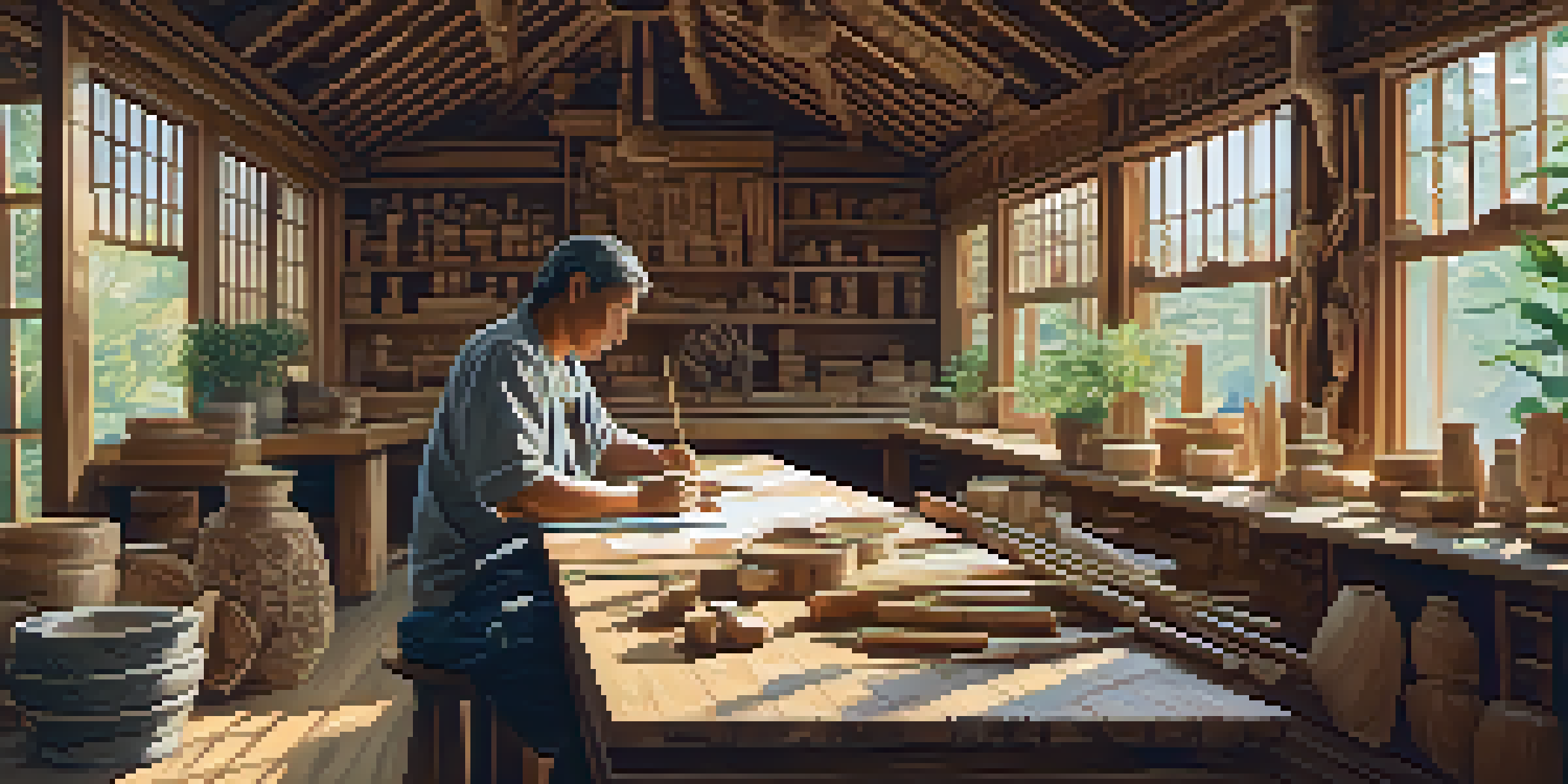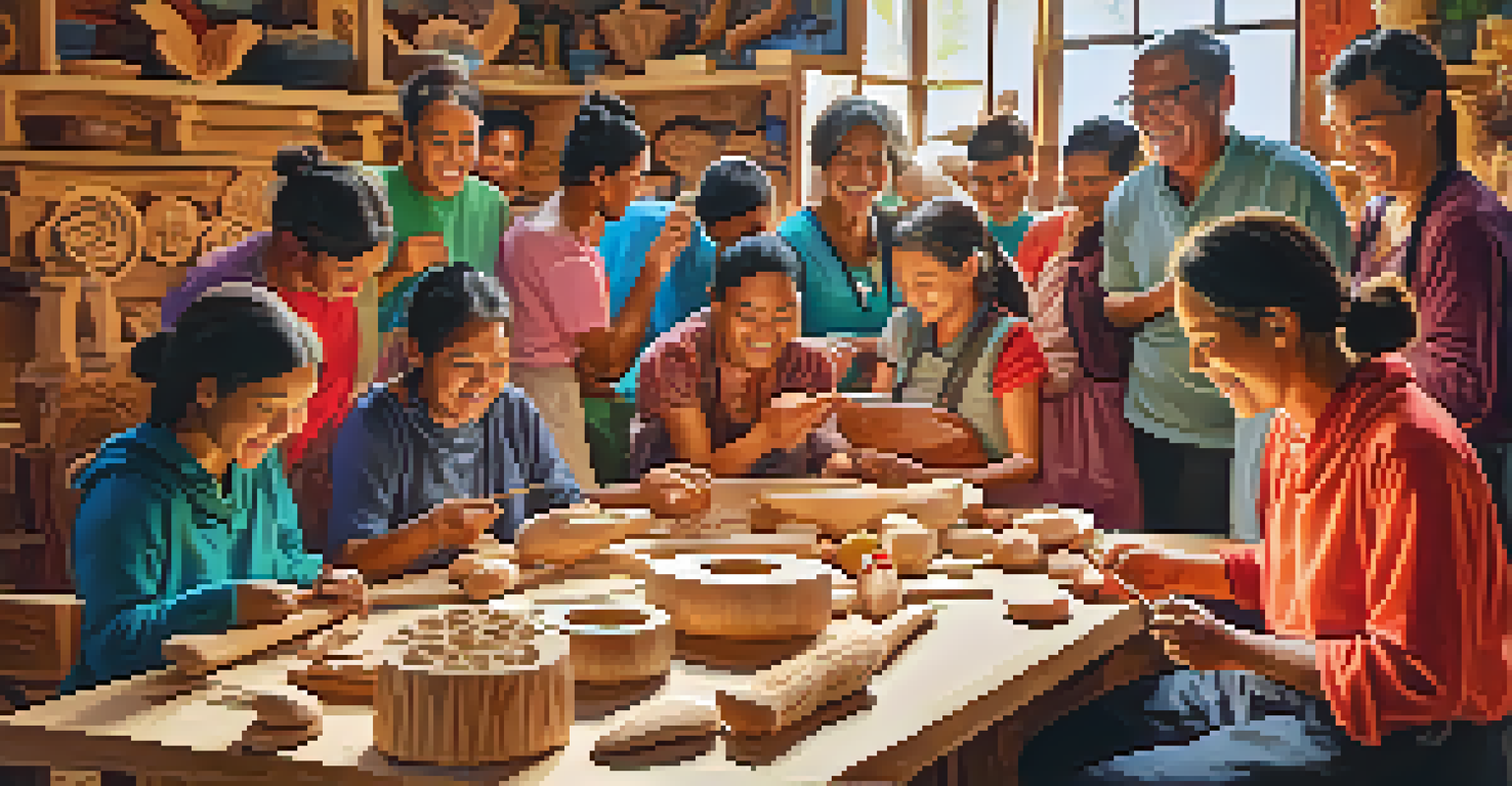Sustainable Carving Practices for Cultural Heritage

Understanding Sustainable Carving Practices
Sustainable carving practices focus on using resources that maintain ecological balance. This means artisans are encouraged to select materials that are renewable and responsibly sourced. By prioritizing sustainability, carvers not only help the environment but also ensure that traditional techniques are preserved for future generations.
The Earth is what we all have in common.
For example, using reclaimed wood instead of newly cut timber can significantly reduce deforestation. This practice not only helps in conserving forests but also gives new life to materials that might otherwise be discarded. Such methods invite creativity and innovation, prompting artisans to explore new designs while respecting the old.
Moreover, sustainable practices often involve local communities, fostering a sense of shared responsibility. When artisans collaborate with local suppliers, they help stimulate the economy while also creating a network of support for cultural heritage. This interconnectedness enhances the value and significance of the carvings beyond their aesthetic appeal.
The Importance of Cultural Heritage in Carving
Cultural heritage represents the history, traditions, and identities of communities. In carving, this heritage is expressed through techniques, symbols, and stories embedded in the artwork. By preserving these practices, we safeguard the narratives that shape cultural identities.

An example of this can be seen in Indigenous carving traditions, where each piece tells a story of ancestry and connection to the land. These carvings are not just decorative; they serve as vital links to the past and educational tools for future generations. Understanding this context helps to appreciate the true value of each creation.
Sustainable Materials Matter
Choosing eco-friendly materials like reclaimed wood and bamboo is crucial for reducing environmental impact and enhancing the beauty of carved items.
As the world becomes increasingly globalized, the risk of losing these unique cultural expressions grows. By emphasizing sustainable carving practices, we can ensure that these traditions not only survive but thrive, enriching our shared human experience.
Choosing Eco-Friendly Materials for Carving
Choosing the right materials is crucial in sustainable carving. Eco-friendly options include bamboo, cork, and reclaimed wood, which have minimal environmental impact. These materials are not only sustainable but often possess unique characteristics that enhance the beauty of the carved items.
Art is not a thing; it is a way.
For instance, bamboo grows rapidly and can be harvested without damaging the ecosystem, making it an excellent choice for artisans. Its strength and flexibility allow for intricate designs that can be both functional and artistic. Similarly, reclaimed wood carries history and character, adding depth to the artwork.
By incorporating these materials, carvers can create pieces that resonate with both environmental consciousness and cultural significance. This thoughtful approach encourages consumers to make informed choices, supporting artisans who prioritize sustainability.
Techniques to Minimize Waste in Carving
Minimizing waste is essential in any sustainable practice, including carving. Artisans can adopt techniques such as using every part of the material, thereby reducing scrap. For example, small offcuts can be transformed into smaller items or even used in mixed media projects.
Another effective technique is to plan designs meticulously before starting the carving process. By visualizing the end product, artisans can maximize the use of their materials and avoid unnecessary waste. This not only enhances efficiency but also fosters creativity in finding new ways to utilize leftover pieces.
Cultural Heritage Preservation
Preserving traditional carving techniques is essential for maintaining cultural identities and passing down important narratives to future generations.
Implementing these waste-minimizing strategies not only benefits the environment but also encourages a mindset of resourcefulness. When artisans view their materials holistically, they can create a more sustainable practice that respects both their craft and the planet.
Community Involvement in Sustainable Carving
Community involvement plays a vital role in promoting sustainable carving practices. By engaging local groups, artisans can share knowledge, skills, and resources, creating a supportive network. This collaboration can lead to enriched cultural expressions that reflect the community's collective heritage.
For instance, workshops that teach sustainable carving techniques can empower younger generations. These initiatives not only preserve traditional arts but also instill values of environmental responsibility. As community members learn together, they forge stronger connections to their heritage and to each other.
Moreover, involving the community can lead to innovative projects that combine various artistic influences. Such collaborations can highlight the beauty of diversity while promoting sustainability, demonstrating that cultural heritage is a living, evolving practice.
Promoting Awareness of Sustainable Practices
Raising awareness about sustainable carving practices is crucial for their long-term success. Educational programs, social media campaigns, and exhibitions can help inform the public about the importance of eco-friendly materials and techniques. The more people understand, the more they will support sustainable artisans.
For example, showcasing the stories behind the carvings can create an emotional connection with consumers. When buyers know the cultural significance and environmental impact of their purchases, they are more likely to choose sustainable options. This shift in consumer behavior can drive demand for responsible practices.
Community Engagement is Key
Involving local communities in sustainable carving practices fosters collaboration, knowledge sharing, and a deeper connection to cultural heritage.
Additionally, collaboration with businesses can amplify these messages. When companies prioritize sustainability in their supply chains, they contribute to a broader cultural shift that recognizes the importance of preserving both the environment and cultural heritage.
Future Directions for Sustainable Carving
The future of sustainable carving holds exciting possibilities as new technologies emerge. Innovations such as 3D printing and laser cutting can enhance traditional methods, allowing for more intricate designs while reducing waste. This blending of old and new techniques can lead to a renaissance in carving practices.
Moreover, as sustainability becomes a global priority, there is a growing market for eco-friendly products. Artisans who embrace sustainable practices can tap into this demand, gaining recognition and support for their work. This shift can create opportunities for collaboration across borders, fostering a global community united by shared values.

Ultimately, the future of sustainable carving is bright, with potential for creativity and cultural preservation. By continuing to prioritize eco-friendly practices, artisans can contribute to a healthier planet while honoring their heritage, ensuring that their art remains relevant and respected.